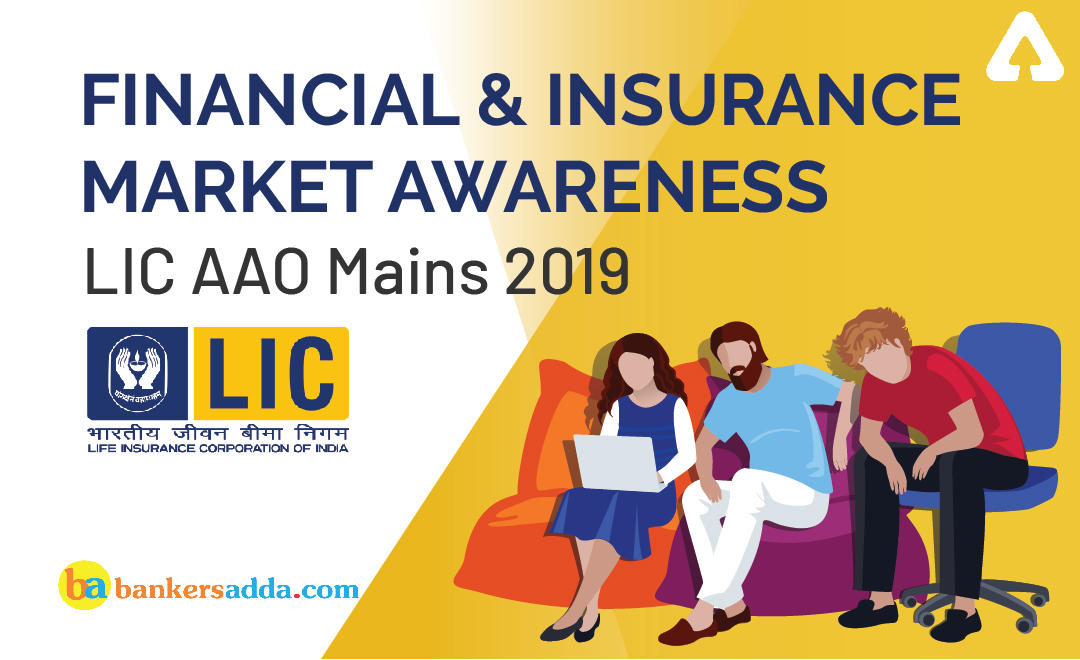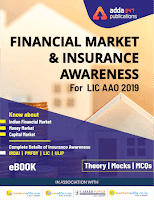Dear Aspirants,
LIC AAO Mains 2019- Financial and Insurance Market Questions
As we know, LIC has released both the vacancies of AAO (Assistant Administrative Officer) & ADO (Apprentice Development Officer). Insurance Market & Financial Awareness is a newly introduced section which will be asked in both the exams. LIC AAO mains 2019 is scheduled to be held on 28th June. While LIC ADO Prelims 2019 is scheduled to be held on 6th & 13th July. Here is a quiz on Insurance Market & Financial Awareness being provided by Adda247 for free to let you practice the best of latest pattern Questions for LIC examination for sure shot selection.
Q1. The financial assistance of loans of Rs. 10000 by a bank to very a small borrower will be called-?
Business Finance
Government Finance
Micro Finance
Small Finance
KYC Finance
Solution:
The financial assistance of loans of Rs. 10000 by a bank to very a small borrower will be called Microfinance.
Q2. What is an Indian Depository Receipt (IDR)?
A deposit account with a public sector bank
A depository account with any of the depositories in India
An instrument in the form of depository receipt created by an Indian depository against underlying equity shares of the issuing company
An instrument in the form of deposit receipt issued by Indian depositories
None of the given options is true
Solution:
An IDR is an instrument denominated in Indian Rupees in the form of a depository receipt created by a Domestic Depository (custodian of securities registered with the Securities and Exchange Board of India) against the underlying equity shares of issuing company to enable foreign companies to raise funds from the Indian securities Markets.
Q3. Many times, we read about future trading in newspapers. What is ‘future trading’?
I. It is nothing but a trade between any two stock exchanges, wherein it is decided to purchase the stocks of each other on a fixed price throughout the year.
II. It is an agreement between two parties to buy or sell an underlying asset in the future at a predetermined price.
III. It is an agreement between stock exchanges that they will not trade the stocks of each other under any circumstances in future or for a given period of time.
Select the correct answer using the codes given below
I. It is nothing but a trade between any two stock exchanges, wherein it is decided to purchase the stocks of each other on a fixed price throughout the year.
II. It is an agreement between two parties to buy or sell an underlying asset in the future at a predetermined price.
III. It is an agreement between stock exchanges that they will not trade the stocks of each other under any circumstances in future or for a given period of time.
Select the correct answer using the codes given below
Only I
Only II
Only III
II and III
None of the given options is true
Solution:
It is an agreement between two parties – a buyer and a seller – wherein the former agrees to purchase from the latter, a fixed number of shares or an index at a specific time in the future for a pre-determined price.
Q4. Which of the following cannot be called as a debt instrument as referred in financial transactions?
Certificate of deposits
Bonds
Stocks
Commercial Papers
None of the given options is true
Solution:
Debt instruments are assets that require a fixed payment to the holder, usually with interest. Examples of debt instruments include bonds (government or corporate), mortgages, Commercial Paper and Certificate of Deposits.
Q5. In the capital market, the term arbitrage is used with reference to-
purchase of securities to cover the sale
sale of securities to reduce the loss on purchase
simultaneous purchase and sale of securities to make profits from price
variation in different markets
None of the given options is true
Solution:
Arbitrage is basically buying a security in one market and simultaneously selling it in another market at a higher price, profiting from the temporary difference in prices. This is considered risk-free profit for the investor/trader.
Q6. Equity schemes managed strong NAV gains which boost their assets’ was a new in some financial newspapers. What is the full form of NAV used as in above headlines?
Nill Accounting Variation
Net Accounting Venture
Net Asset Value
New Asset Venture
Normal Asset Venture
Solution:
Equity schemes managed strong Net Asset Value (NAV) gains which boost their assets’ was a new in some financial newspapers.
Q7. SEBI is a/an-
advisory body
statutory body
constitutional body
non-statutory body
registered as a society
Solution:
Securities and Exchange Board of India (SEBI) is the regulator for the securities market in India. It was established in the year 1988 and given statutory powers on 30 January 1992 through the SEBI Act, 1992.
Q8. Which of the following bodies promoted Securities Trading Corporation of India Limited (STCI) jointly with the public sector banks?
SEBI
TRAI
NABARD
RBI
IRDAI
Solution:
STCI Finance Ltd. (formerly known as Securities Trading Corporation of India Limited), is a systemically important non-deposit taking NBFC registered with Reserve Bank of India. Presently STCI Finance Ltd is classified as a loan NBFC.
Q9. Commercial paper are issued by-
company to a bank
banks to companies
bank to banks
company to its suppliers
None of the above
Solution:
Commercial paper is an unsecured form of promissory note that pays a fixed rate of interest. It is typically issued by large banks or corporations to cover short-term receivables and meet short-term financial obligations, such as funding for a new project.
Q10. Which of the following can be identified as a demat account?
Accounts which can have zero balance
Accounts opened to facilitate repayment of loan
Accounts in which shares of companies are traded in electronic form
Accounts maintained by mutual fund companies for investors
None of the given options is true
Solution:
Dematerialized account number is quoted for all transactions to enable electronic settlements of trades to take place. Every shareholder will have a Dematerialized account for the purpose of transacting.
Q11. General Insurance Corporation (GIC) of India is a state owned enterprise in India. Where is the head office of GIC?
Kolkata
Chennai
New Delhi
Mumbai
Hyderabad
Solution:
GIC of India is a state owned enterprise in India. The head office of GIC is in Mumbai.
Q12. Life Insurance Corporation of India is an Indian state-owned insurance group and investment company. In which year LIC was founded?
1956
1952
1961
1935
1955
Solution:
Life Insurance Corporation of India is an Indian state-owned insurance group and investment company headquartered in Mumbai. It was founded in 1956.
Q13. General Insurance Corporation (GIC) of India was incorporated on _________________________ under the Companies Act, 1956 as a private company limited by shares.
01st July 1955
01st April 1935
22nd November 1972
12th April 1992
12th November 1992
Solution:
General Insurance Corporation of India (GIC) was formed in pursuance of Section 9(1) of GIBNA. It was incorporated on 22 November 1972 under the Companies Act, 1956 as a private company limited by shares. GIC was formed for the purpose of superintending, controlling and carrying on the business of general insurance.
Q14. LIC was formed by an Act of Parliament, viz. LIC Act, 1956, with a capital contribution of Rs. _______________ from the Government of India.
Rs. 10 crore
Rs. 50 crore
Rs. 100 crore
Rs. 1 crore
Rs. 5 crore
Solution:
LIC formed by an Act of Parliament, viz. LIC Act, 1956, with a capital contribution of Rs. 5 crore from the Government of India.
Q15. Who is present Chairman-cum-Managing Director of GIC?
Tajinder Mukherjee
Alice G Vaidyan
TL Alamelu
Atul Sahai
AV Girija Kumar
Solution:
Mrs Alice G Vaidyan is present Chairman-cum-Managing Director of GIC .







